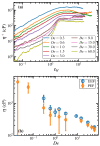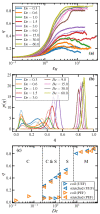Atomistic Simulation of Flow-Induced Microphase Separation and Crystallization of an Entangled Polyethylene Melt Undergoing Uniaxial Elongational Flow and the Role of Kuhn Segment Extension
- PMID: 37111978
- PMCID: PMC10146043
- DOI: 10.3390/polym15081831
Atomistic Simulation of Flow-Induced Microphase Separation and Crystallization of an Entangled Polyethylene Melt Undergoing Uniaxial Elongational Flow and the Role of Kuhn Segment Extension
Abstract
Atomistic simulations of the linear, entangled polyethylene C1000H2002 melt undergoing steady-state and startup conditions of uniaxial elongational flow (UEF) over a wide range of flow strength were performed using a united-atom model for the atomic interactions between the methylene groups constituting the polymer macromolecules. Rheological, topological, and microstructural properties of these nonequilibrium viscoelastic materials were computed as functions of strain rate, focusing on regions of flow strength where flow-induced phase separation and flow-induced crystallization were evident. Results of the UEF simulations were compared with those of prior simulations of planar elongational flow, which revealed that uniaxial and planar flows exhibited essentially a universal behavior, although over strain rate ranges that were not completely equivalent. At intermediate flow strength, a purely configurational microphase separation was evident that manifested as a bicontinuous phase composed of regions of highly stretched molecules that enmeshed spheroidal domains of relatively coiled chains. At high flow strength, a flow-induced crystallization (FIC) occurred, producing a semicrystalline material possessing a high degree of crystallinity and primarily a monoclinic lattice structure. This FIC phase formed at a temperature (450 K) high above the quiescent melting point (≈400 K) and remained stable after cessation of flow for temperature at or below 435 K. Careful examination of the Kuhn segments constituting the polymer chains revealed that the FIC phase only formed once the Kuhn segments had become essentially fully extended under the UEF flow field. Thermodynamic properties such as the heat of fusion and heat capacity were estimated from the simulations and found to compare favorably with experimental values.
Keywords: Kuhn segment extension; flow-enhanced nucleation; flow-induced crystallization; microphase separation; molecular simulation; polyethylene; uniaxial elongational flow.
Conflict of interest statement
The authors declare no conflict of interest.
Figures



















Similar articles
-
Configurational Microphase Separation in Elongational Flow of an Entangled Polymer Liquid.Phys Rev Lett. 2018 Dec 14;121(24):247802. doi: 10.1103/PhysRevLett.121.247802. Phys Rev Lett. 2018. PMID: 30608755
-
Communication: A coil-stretch transition in planar elongational flow of an entangled polymeric melt.J Chem Phys. 2018 Apr 14;148(14):141103. doi: 10.1063/1.5026792. J Chem Phys. 2018. PMID: 29655328
-
Nonequilibrium Thermodynamics of Polymeric Liquids via Atomistic Simulation.Entropy (Basel). 2022 Jan 25;24(2):175. doi: 10.3390/e24020175. Entropy (Basel). 2022. PMID: 35205471 Free PMC article.
-
Effect of the Elongational Flow on the Morphology and Properties of Polymer Systems: A Brief Review.Polymers (Basel). 2021 Oct 14;13(20):3529. doi: 10.3390/polym13203529. Polymers (Basel). 2021. PMID: 34685288 Free PMC article. Review.
-
Polymer crystallization under external flow.Rep Prog Phys. 2022 Feb 18;85(3). doi: 10.1088/1361-6633/ac4d92. Rep Prog Phys. 2022. PMID: 35060493 Review.
Cited by
-
Preparation and Characterization of High-Density Polyethylene with Alternating Lamellar Stems Using Molecular Dynamics Simulations.Polymers (Basel). 2024 Jan 22;16(2):304. doi: 10.3390/polym16020304. Polymers (Basel). 2024. PMID: 38276712 Free PMC article.
-
Chain-Level Analysis of Reinforced Polyethylene through Stretch-Induced Crystallization.ACS Macro Lett. 2024 Feb 20;13(2):247-251. doi: 10.1021/acsmacrolett.3c00554. Epub 2024 Feb 8. ACS Macro Lett. 2024. PMID: 38329290 Free PMC article.
References
-
- Laun H., Schuch H. Transient elongational viscosities and drawability of polymer melts. J. Rheol. 1989;33:119–175. doi: 10.1122/1.550058. - DOI
-
- Nielsen J.K., Rasmussen H.K., Hassager O., McKinley G.H. Elongational viscosity of monodisperse and bidisperse polystyrene melts. J. Rheol. 2006;50:453–476. doi: 10.1122/1.2206711. - DOI
-
- Huang Q., Mednova O., Rasmussen H.K., Alvarez N.J., Skov A.L., Almdal K., Hassager O. Concentrated polymer solutions are different from melts: Role of entanglement molecular weight. Macromolecules. 2013;46:5026–5035. doi: 10.1021/ma4008434. - DOI
-
- Costanzo S., Huang Q., Ianniruberto G., Marrucci G., Hassager O., Vlassopoulos D. Shear and extensional rheology of polystyrene melts and solutions with the same number of entanglements. Macromolecules. 2016;49:3925–3935. doi: 10.1021/acs.macromol.6b00409. - DOI
Grants and funding
LinkOut - more resources
Full Text Sources

